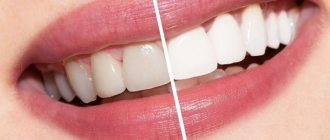Halitosis
(halitosis; from Latin halitus - breath and Greek -osis - disease) or halitosis is a term used to describe a noticeably unpleasant odor when exhaling.
It is known to be the third most common reason, after tooth decay and gum disease, that prompts people to visit the dentist.
For a person with halitosis, the symptoms are invisible because the olfactory receptors become accustomed to the stench. In most cases (90%) the cause of bad breath is in the mouth.
The intensity of this phenomenon can change throughout the day due to the consumption of odorous foods such as cheese, fish, seasonings, garlic, alcohol, as well as smoking and, in general, overeating.
Since self-cleaning does not occur in the mouth during sleep, halitosis is usually more intense in the morning (“kittens wrote in their mouth”).
Bad breath can be ephemeral (going away after rinsing with a freshener or brushing your teeth) and persistent.
Sustained (chronic, persistent) halitosis is present in 25% of the population.
Causes of halitosis.
In the mouth.
There are more than 600 types of microorganisms in the average person's mouth. About a hundred of them can produce a stench even when grown in a laboratory.
Solobacterium moorei is a microorganism that is recognized by some researchers as the most active producer of stench.
This stench is produced mainly due to the decomposition of proteins into individual amino acids with their further decomposition into odorous substances.
For example, the decomposition of cysteine and methionine produces hydrogen sulfide and methyl mercaptan, respectively. Volatile sulfur compounds have been shown to be statistically related to the degree of halitosis and usually disappear with adequate treatment.
1.1. The tongue is where odor in the mouth appears in most cases.
A significant amount of natural microflora is localized in the villi and folds of the back of the tongue, especially on the back (root of the tongue).
This part of the tongue is relatively poorly cleaned and the bacterial population multiplies here on food debris, dead cells and nasal mucus.
Such a nutritional environment on the back of the tongue is ideal for anaerobic bacteria that produce a specific gas, the components of which are:
- putrid odor of indole substances,
- skatola,
- polyamines;
- “rotten egg” smell of volatile sulfur compounds (hydrogen sulfide, methyl mercaptan, allyl methyl sulfide and dimethyl sulfide).
Cleaning the tongue.
Chewing gum, sprays, rinses, etc. can only temporarily muffle the odor produced by bacteria on the root of the tongue, but cannot eliminate halitosis because they do not eliminate its cause.
To neutralize the release of the above-mentioned volatile sulfur compounds, it is necessary to remove plaque from the back of the tongue along with the aerobic and anaerobic microorganisms contained in it.
Typically, a tongue scraper or toothbrush is used for this.
1.2. Gum diseases (periodontitis).
There is some controversy regarding the role of gum disease in the formation of bad breath. However, advanced periodontitis is always the cause of halitosis.
The waste products of anaerobic bacteria developing in periodontal pockets have a disgusting odor and, as has been clinically proven, lead to severe halitosis.
Removing calculus (tartar) and loose gums has been proven to significantly freshen the smell of your mouth. It is desirable that this event be accompanied by subgingival scaling, root planing and tissue irrigation with antimicrobial agents.
1.2.1. Particular attention should be paid to pericoronitis of the wisdom tooth.
- inflammation of the gums around the eighth tooth that has not fully erupted. After the exacerbation is relieved, it is reasonable to remove these teeth.
1.2.2.
Fetid sore throat and
Vincent's stomatitis.
Tonsils (chronic tonsillitis).
In general, suppuration from the tonsils is considered statistically insignificant in the occurrence of halitosis (only about 5%). About 7% of the population suffers from tonsillar plugs, small pieces of calcified material in the folds of the tonsils.
They smell extremely unpleasant and when released can cause halitosis.
Nasal passages.
The nose is the second major cause of halitosis due to sinusitis and foreign bodies. In this case, the smell rather comes from the nose and is different from bad breath.
Esophagus.
The cardiac valve between the stomach and esophagus may not close well when the stomach herniates into the esophagus, allowing acid and stomach gases to leak into the mouth. With diverticulosis (false pouch) of the esophagus, deposited food debris can cause halitosis.
Stomach
Rarely is the cause of halitosis; belching should not be confused with the latter. With reflux (backward release of stomach contents), an odor may appear.
Liver.
Hepatic respiration (fetor hepaticus) is a condition associated with portal hypertension and liver failure. In this case, odorous digestive products (mercaptan, ammonia, ketones), instead of being destroyed in the liver, enter the lungs and, accordingly, into the exhaled air.
The breath has a sweetish, fecal tint. In this case, the fight against symptoms is no longer relevant.
Lungs and bronchi in acute and chronic inflammation and tumors (carcinoma).
Other diseases:
- renal failure,
- diabetes,
- metabolic diseases.
Microflora of the oral cavity
The human oral cavity is a unique ecological system. The permanent microflora in the mouth is formed by hundreds of different organisms; a moist, relatively warm environment creates favorable conditions for their reproduction.
The following play a significant role in the composition of the normal microflora of the oral cavity:
- veillonella, which neutralize acidic foods;
- bacteria of the genera Propionibacterium, Corynebacterium and Eubacterium, producing molecular oxygen;
- lactobacilli;
- rod-shaped lactobacilli - producers of lactic acid;
- bifidobacteria, necessary for the fermentation of carbohydrates and the production of B vitamins and others.
It is difficult to overestimate the importance of healthy oral microflora for the body. It is in this environment that the primary process of food digestion occurs, and therefore the absorption of vitamins and nutrients. Normal microflora is necessary for the proper functioning of the immune system and protecting the body from various fungal, bacterial and viral infections.
With the uncontrolled proliferation of opportunistic microflora and an imbalance of bacteria in the oral mucosa, oral dysbiosis occurs, an extremely unpleasant disease that provokes damage to tooth enamel and gums and can lead to extremely serious consequences for the entire body.
Diagnosis of halitosis.
Self-diagnosis.
Smelling your own breath is difficult due to the adaptation of the olfactory receptors, although many halitosis sufferers can smell it in others.
Sometimes people experience an unpleasant taste in their mouth, but this is not always accompanied by halitosis. Usually people reliably learn about the presence of halitosis from their loved ones or from their doctor.
Special diagnostics.
It is required if the possible causes of halitosis, especially in the mouth, have been eliminated.
2.1. Halitometer
This is a device that determines the amount of hydrogen sulfide in exhaled air. Other odorous agents, such as mercaptan, are not detected by this device.
2.2. Digital gas chromatograph
measures the molecular level of major halitosogenic substances.
Consumption of which alcoholic drinks leads to a strong amber?
How to remove the smell of alcohol: with pharmaceutical drugs, using folk recipes or brushing your teeth - all these methods will help to a greater or lesser extent, but the most important thing is to figure out which types of alcohol cause a stronger aroma. It depends on the quality of the drink and the impurities it contains. You can consider each type of alcohol-containing product:
Vodka is considered the “safest” if drunk in moderation. It does not contain dyes, additives, or flavors. It instantly intoxicates, but the fumes dissipate faster in the morning compared to other representatives of this product. Scientists have proven that the liver can easily process two hundred grams of vodka in 5 hours + the same time will be required for complete breakdown and removal of ethanol from the body. After 10 hours, the smell of alcohol from your mouth will completely disappear.
Beer takes longer to be excreted compared to vodka products, but this is provided that it does not contain impurities, is of natural origin, and was not taken in large quantities.
Cognac is an expensive, elite, prestigious product, but it has the longest dissolution time. It contains food colorings and impurities to improve the taste, this affects the inhibition of the breakdown period, and it will not be easy to get rid of the fumes.
Natural wine - this option has several types of alcohol content: fortified - processed by the body and disappears after 8 hours if 100 grams of this liquid are taken; dry – 6 hours; champagne – 3 hours
Carbonated alcoholic cocktail in cans - its taste is not worth the harm it causes to humans. It breaks down hard and takes a long time - about 8 hours, and the persistent aroma will last up to 14 hours.
Mixing alcoholic beverages of different types with different alcohol contents is very dangerous. Firstly, it is harmful to health and leads to a violent hangover, and secondly, such products break down more slowly and are poorly washed out of the body.
Treatment and prevention.
1.
It is known that very few people observe sufficient personal hygiene measures necessary for fresh breath.
This is, firstly, adequate teeth cleaning using electric, sonic and ultrasonic toothbrushes and irrigators with quality control using special plaque indicators.
Secondly, it is advisable to clean the tongue with a scraper and brush. Medicinal rinses are also appropriate.
2.
Diet. When eating raw, hard vegetables and fruits, the oral cavity self-cleanses.
3.
High-quality regular, if necessary repeated, professional teeth cleaning with removal of plaque and stones using ultrasound and sandblasting (air-flo).
Sometimes deep scaling, root planing and gum margin management are required. In advanced cases, reconstructive gum surgery is used.
4.
Dental treatment and adequate dental prosthetics.
Drug therapy.
1.
Antimicrobial drugs.
2.
Probiotics. For example Streptococcus salivarius K12.
6. Traditional medicine.
Camomile tea.
Pour a teaspoon of chamomile flowers into a glass of boiling water, leave for 2 hours, strain. Rinse your mouth with freshly prepared chamomile infusion 3 times a day.
What pharmaceutical products will help in the fight against halitosis?
If the reason lies in systemic disorders or pathological conditions of the oral cavity, you cannot do without the help of a specialist. You can mask the problem on your own, but it is impossible to solve it completely without appropriate examination and adequate treatment. However, as part of supportive symptomatic therapy, the patient may be prescribed special pharmaceuticals - let’s look at the possible options in a little more detail.
Mouth rinses
A good mouthwash with an excellent reputation is Elmex. Its daily use provides reliable prevention of caries and other pathological processes. The liquid disinfects the mucous membrane and dental tissues, helps normalize the balance of microflora in the oral cavity. The product does not need to be diluted with water - just rinse your mouth with it for a minute and spit it out. After this, it is advisable to give up drinks and food for about an hour.
Another good remedy is Lacalut Aktiv - its active ingredients help relieve acute inflammation and have a pronounced antibacterial effect. This rinse is often prescribed as part of the supportive symptomatic treatment of inflammatory diseases of the gums and periodontal tissues. It is recommended to use it after every brushing of your teeth - morning and evening.
Daily use of mouth rinses improves hygiene
Splat complete mouthwash has a powerful anti-inflammatory effect and is often used during treatment and for the prevention of periodontitis. Helps remove plaque and dissolve hardened deposits. According to the manufacturer, it can be used freely throughout the day - you can rinse your mouth with it as many times as you like. The composition contains essential oils that prevent the rapid spread of carious processes, help freshen breath and prevent darkening of the enamel.
Sprays for fresh breath
The range of hygiene products also includes special sprays - most often their action is aimed at combating unpleasant “odors”. So, for example, President with eucalyptus flavor can be used as needed. The spray does not contain alcohol, and therefore its use does not limit the ability to drive a vehicle in any way. 1-2 sprays are enough to give pleasant freshness to your breath. One bottle is enough for an average of 200 uses.
A spray helps to overcome the symptom well
There is another good product in spray form - Amway glister. The liquid has a pleasant menthol aroma and helps to forget about an unpleasant symptom for a long time, kills the “aromas” of food and tobacco. Also suitable for use as needed. Contains mint and eucalyptus oils, as well as menthol. The spray is sold in 25 ml metal bottles.
Preventative toothpastes
A correctly selected paste can provide not only a preventive, but also a therapeutic effect. Thus, silicon dioxide is present, which helps lighten the enamel, as well as lysozyme, which provides protection against the growth of pathogenic microflora. Perilla seed extract helps restore the microflora of the oral cavity and thereby get rid of foreign odors. The manufacturer claims that the product consists of 98% natural ingredients and is therefore completely harmless to the body1. Reviews confirm that a noticeable effect can be detected after 3-4 weeks of regular use of the paste.
An additional treatment aid is properly selected toothpaste.
Toothpaste “Morning Freshness” from the Primaflora trademark is more like a gel in consistency with a pleasant mint taste. The product has a pronounced antimicrobial effect, and also helps to activate trophism in the mucous membrane and restore the elasticity of the gums. It contains extracts of pine, fir, rose, lemon and viburnum, as well as thermal water, which provides light mineralization and strengthening of dental tissues.
Blend-a-med 3D white “Arctic Freshness” paste will help to effectively freshen your breath. It not only whitens the enamel, but also fights unpleasant odors and helps strengthen the gums by activating blood flow in them.
Halitosis and exposed roots
Two recent studies show that volatile chemicals and the gas that causes halitosis have damaging effects on surrounding tissue.
The first study demonstrates the role of hydrogen sulfide (SH2), which causes periodontal cell death through apoptosis (fragmentation or programmed destruction).
Another study shows that the same hydrogen sulfide (SH2) accelerates the proliferation (reproduction) of bone-destructive cells (osteocasts).
These are cells that take part in the physiological (normal) remodeling of bone: the phenomenon of bone resorption, which allows, among other things, orthodontic movements, during which the activity of bone-building cells (osteoblasts) is balanced with the activity of osteoclasts.
Under the influence of hydrogen sulfide, cellular metabolism accelerates, triggering the mechanism of bone destruction under the influence of osteoclasts.
The balance is thus disturbed and bone resorption develops. This results in periodontal disease (periodontitis) and exposed roots.
The vicious circle is complete because periodontitis and exposed roots are a common cause of halitosis (bad breath).
Halitosis and pulpitis
Hydrogen sulfide, released during halitosis (bad breath), is also toxic to pulp cells. One study demonstrates that hydrogen sulfide profoundly disrupts the metabolism of the mitochondrial membranes of dental cells, causing cell death through apoptosis (breakdown into fragments).
Situated in the pulp chamber in the center of the tooth, the pulp is not isolated from the surrounding oral environment because exchange constantly occurs through dentin, a porous tissue, and enamel, which acts as a selective membrane.
Hydrogen sulfide penetrates and diffuses through the hard tissues of the tooth to negatively affect its vitality.
This phenomenon may explain the appearance of pulpitis (inflammation of the pulp) in intact (undamaged) teeth. It should be noted that tobacco smoke can have a toxic effect on the dental pulp through a similar mechanism.
In the case of pulpitis, divitalization or removal of the nerve is the only possible solution.
Review of popular and effective remedies for unpleasant odors
There are several proven effective drugs that, according to reviews, help better than others in the fight against halitosis. Below is a rating of the top most effective products, the correct use of which helps not only get rid of an unpleasant odor, but also eliminate the cause of its appearance.
"Septogal" - lozenges
The review opens with a combination drug in tablet form - Septogal. The active components of the product have a direct effect on most types of bacteria and viruses. Essentially, it is a medicine that is sometimes prescribed as part of the treatment of infectious diseases, in particular to combat halitosis as a symptom of a pathological process in the oral cavity.
Septogal tablets will help fight unpleasant odors
The composition contains sucrose, so the drug is not prescribed to patients with diabetes. The tablets are intended to be dissolved every 2-3 hours during the day. After taking it, you should not eat or drink milk for an hour. The drug is contraindicated if you are allergic to menthol, mint or eucalyptus.
Spray or solution "Miramistin" with antibacterial effect
An antiseptic solution, tasteless and odorless, forms a persistent foam when the bottle is shaken. The active components included in the composition act on pathogenic microflora from the inside, effectively destroying yeast-like fungi, viruses, and infectious agents. The drug can be safely used during pregnancy, which only confirms the absolute safety of its composition.
In some cases, Miramistin is prescribed
Halitox drops to combat the cause of the problem
The drops do not mask the odor, but act directly on the cause of its appearance. The use of the drug helps to gently cleanse the body of decay products and helps in the fight against parasites. It contains only natural substances, including mountain propolis extract for a bactericidal effect and effective removal of toxins. Black walnut fights parasites and harmful microorganisms, and eucalyptus helps normalize the condition of the respiratory system. Just add 5 drops to a glass of water and take the product before bed.
Halitox drops also help well with the problem
Spray "Lakalut" for antiseptic treatment
Provides complete prevention of caries and effectively disinfects tissues in the oral cavity. Helps remove plaque from teeth and kills pathogenic microflora, mainly due to the presence of chlorhexidine in the composition. There is also peppermint oil here - an excellent help in the fight against halitosis. However, the drug should not be used by children and women during pregnancy, since it contains alcohol.
"Lacalut" - spray fights well against the symptoms of halitosis
Hydrogen peroxide
This is a simple and affordable remedy that can be systematically used for prevention. It is effective not only against infectious and carious processes, but also to combat intensive plaque formation and the formation of deposits. It is enough to take 3% hydrogen peroxide and dissolve 4 teaspoons in a glass of plain boiled water at room temperature. The prepared solution can be used as needed.
Hydrogen peroxide solution effectively fights deposits
What causes the stink: dental reasons
Halitosis is caused by pathogenic microorganisms. Unfortunately, it is not always possible to remove them using normal hygiene procedures, because we can talk about various diseases that require treatment. Let's consider several ailments that can provoke a similar symptom:
- Insufficient hygienic treatment. A standard brush and toothpaste do not thoroughly clean plaque and food particles that are stuck between the teeth. For this reason, dentists strongly recommend adding rinse, floss, and irrigator to your arsenal. It is advisable to carry out all hygiene procedures after each meal to prevent the accumulation and compaction of plaque.
- Pathological processes localized in the gums. Bad breath usually occurs due to gingivitis, periodontitis, or periodontal disease. To eliminate this problem, it is necessary to treat the root cause and restore gum health.
- Presence of carious cavities. In a colloquial format, they say about this disease that “the tooth is rotting,” so you don’t have to wonder where the foul aroma comes from. If the cavities are large, they are constantly filled with food, which is quite difficult to get out even with the most modern hygienic devices.
- Stomatitis. This disease is characterized by the appearance of small whitish dots filled with pus. They promote the active proliferation of pathogenic microorganisms and provoke the appearance of stink from the mouth.
- Stone formation. Dentists assure that even banal tartar, which occurs in every second person, provokes this symptom. The solution is to remove the stone in the doctor's office.










